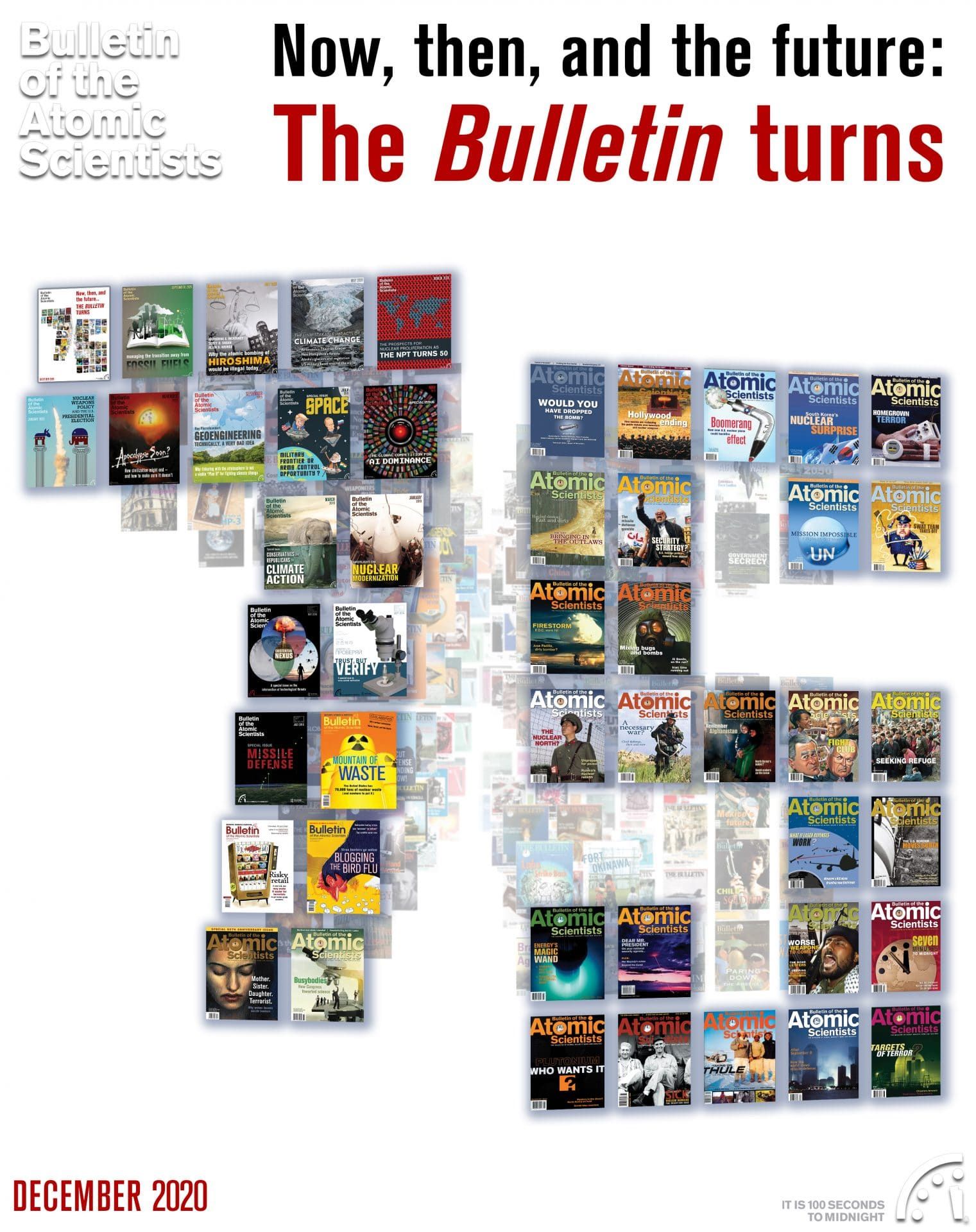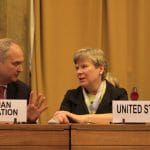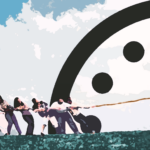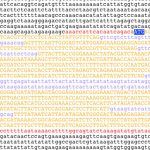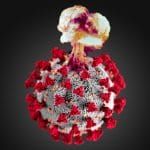Interview: Nobel chemistry laureate Jennifer Doudna on the promise and peril of the genetic editing revolution
By John Mecklin | December 27, 2020
Interview: Nobel chemistry laureate Jennifer Doudna on the promise and peril of the genetic editing revolution
By John Mecklin | December 27, 2020
Just weeks after I interviewed her this September, UC Berkeley professor Jennifer Doudna and her colleague Emmanuelle Charpentier were jointly awarded the Nobel Prize in Chemistry for their discovery of the CRISPR/Cas9 genetic editing tool. An acronym for Clustered Regularly Interspaced Short Palindromic Repeats, CRISPR sequences were found in bacteria, where they protect against viruses by chopping them into pieces. Doudna and Charpentier devised a way to reprogram these genetic scissors, so they could be directed to cut any DNA molecule at a predetermined site.
The CRISPR/Cas9 editing tool has greatly reduced the amount of time needed to edit genes and is now in use by researchers around the world. “There is enormous power in this genetic tool, which affects us all. It has not only revolutionized basic science, but also resulted in innovative crops and will lead to ground-breaking new medical treatments,” Claes Gustafsson, chair of the Nobel Committee for Chemistry, said in a press release accompanying the Nobel Prize announcement.
The positive potential of CRISPR editing tools is indeed breathtaking. “This tool has contributed to many important discoveries in basic research, and plant researchers have been able to develop crops that withstand mold, pests and drought,” the Nobel press release said. “In medicine, clinical trials of new cancer therapies are underway, and the dream of being able to cure inherited diseases is about to come true.”
CRISPR is, as the Nobel announcement notes, “a tool for rewriting the code of life”—a capability that gives rise to a host of ethical issues and the possibility of misuse. The prospect of “designer babies,” for example, garnered international attention in 2018, when the Chinese scientist He Jiankui announced that he used CRISPR/Cas9 to edit the genomes of fertilized human eggs, producing the world’s first genetically edited human babies—to worldwide scientific consternation.
I asked Doudna whether she thought the line could be held, and scientists would largely refrain from editing the inheritable human germline. Her answer was direct and hopeful, but not polyannaish. “I mean, this is a big experiment: Can you really ask a global community—in this case of scientists, researchers, and clinicians—can you ask them to band together and really create a global feeling of being on the same team in a way, no matter what country you come from? Time will tell.”
John Mecklin:
Why don’t we start out with what’s good about the gene editing system, CRISPR/Cas9, and the other ones that you’ve developed? I mean, what—in the next five years, 10 years—what can humans really positively expect to see?
Well, I would say, first and foremost, it’s an incredible tool for scientists to conduct research. So it puts in the hands of any molecular biologist the ability to manipulate the DNA and cells and organisms. That means we can now test the function of genes. We can understand how genes interact together, and more than that, we can actually do something about it. We can actually make corrective changes to genes if they are dysfunctional. So, that is just an extraordinary capability that now is available to scientists worldwide, because the CRISPR technology, I think fundamentally, is a democratizing tool. It can be adopted readily. It’s not expensive to use. And it provides an extraordinary set of tools for manipulating DNA in any cell. And then in a more practical sense, I think within the next five years we’re going to see increasing applications across medicine and agriculture.
We’ve already seen just in the first eight years of CRISPR as a genome editing tool, we’re already at a point where people are receiving this technology as a treatment or even a cure for genetic disease. The first example of that was sickle cell disease, for which a cure in a patient, Victoria Gray, was announced a few months ago. So, I think that just sort of highlights where this technology is headed.
And in agriculture, same thing. There’s really just an incredible opportunity right now for plant breeders to manipulate the genes of plants in ways that will be beneficial and give plants the ability to deal with drought and other impacts of climate change, [abilities that] are relevant, I would say, here in California in particular, but literally probably everywhere. I think, again, over the next five years we’ll see increasing uses in agriculture that will start to bring those edited plants to market.
So, big questions that will have to be dealt with are how to deal with regulation and acceptance. But technologically, that capability is now in our hands.
John Mecklin:
You sort of verged into my next question. Obviously there is a potentially negative side; any technology can be misused, and the power of this technology is great. Where is regulation in terms of using this technology right now? It seems to me it’s kind of nonexistent.
Jennifer Doudna:
Well actually, I would say something that’s very interesting about CRISPR is that it fundamentally is a technology that builds on a lot of other advances in biology over the last 40 or 50 years. And back in the mid-‘70s, there was a meeting called the Asilomar Conference that was held here in California, that was convened to discuss the ethics and safety of molecular cloning, which means being able to make copies of segments of DNA, copies of genes. Scientists at that time were very excited about the ability to do that, to cut and paste genes and use them to produce molecules and bacteria, but there was also an appreciation that that technology could be risky.
And so, because of that meeting a whole series of regulations put in place here in the United States that ended up having a global impact in many countries. It made similar guidelines for using molecular cloning. And we find that a lot of those guidelines and regulations are now very much appropriate for CRISPR. And so, that really has provided a very useful framework for rolling out CRISPR technology. That being said, as you alluded to, there are certainly potential applications of CRISPR that go beyond that current regulatory framework, and that I think require attention. A couple of those applications include heritable germline editing in humans—meaning making permanent changes to the DNA of embryos that would lead to changes to the DNA that could be inherited by future generations—as well as applications in plants or insects in the environment that could have an environmental impact.
And so, these are areas where I feel very strongly that there needs to be additional attention paid, potentially additional regulatory guidelines and requirements put in place. And actually, this conversation we’re having today is very timely, because today the National Academies of Science in the US and in the United Kingdom announced that they were releasing a report on heritable human genome editing, and kind of putting in place a framework around how to regulate that going forward.
John Mecklin:
Have you had a chance to read the report?
Jennifer Doudna:
Well, it’s 225 pages long. I have it actually open here on my computer. I haven’t read every word of it, I have to admit to you; it was just released today. But they have a very nice summary there with a set of recommendations, and I think that even just taking a look at that, it’s clear that there was a lot of effort and work put into this. It’s a very thoughtful document, and I think it provides a very concrete set of recommendations for how to manage this technology going forward.
John Mecklin:
It is truly an international technology now. I was surprised, looking at how many different countries research into this is going on. How do you bring reasonable regulation to something moving this fast all around the world? What do you do about outlier countries?
Jennifer Doudna:
Well, it’s certainly challenging. I think that one of the recommendations in this report is to create two international commissions that would be truly representative of countries around the world that are using this technology. And the purpose of those commissions would be to review work that’s going on globally with genome editing in these sorts of areas where there could be a global impact either environmentally or in the human germline. And then also, sort of creating a forum for transparency, because I think one of the issues that scientists have faced up until now with this technology—but frankly, with other emerging technologies in the biological sciences more broadly—is that there hasn’t really been a mechanism for that kind of transparency. Certainly not in a global sense. And so, I think that’s the purpose of at least one of these commissions would be to provide a group of people who could serve in that role.
John Mecklin:
I admit it would be an interesting experiment. Given what happened in China with the edited babies there, do you really think a commission like that—that certain countries would report honestly? On what they’re up to in these realms? It seems like it’s thought of as national security in some places.
Jennifer Doudna:
Well, I think you’re alluding to it: It’s very hard to enforce something like this. I don’t really see a way to do it in a legal sense, but I do think that in the community of scientists there’s been a lot of discussion about why was the work announced from He Jiankui creating CRISPR babies. Why did he do that work? And I think a strong motivator in that case was that, as deluded as it may sound, I think he was really thinking of it as a kind of a breakthrough in science. And so, there was a motivation to be first, to be famous, to be seen as a pioneer. And so, I think one of the goals of these international commissions is to really try to set standards for what the scientific community, at least, would consider ethical and appropriate, and to make sure that it’s very clear that certain types of applications of genome editing, just aren’t acceptable to the scientific community and would not be rewarded if they were carried out.
John Mecklin:
In the aftermath of World War II, the people who created the bomb had this real strong, ethical imperative: We really need to do something so that the world isn’t ended. Is that something in your travels going to conferences, speaking to many researchers in this area—is that generally felt about this kind of technology, gene editing, that it is that important and that they have an ethical duty to get something done to manage it?
Jennifer Doudna:
I think some people do. I think some people definitely have that sense of, kind of in a way a historical view of this work, that this is a transformative moment really in biological research and in human capabilities that will really change the future in ways that when historians look back, a hundred years from now or so, or even less than that, it’ll be clear that this was a kind of a turning point. But I think many scientists don’t think about that. They don’t do their work that way personally, and they don’t necessarily see it being connected in a more global sense. So, I have found in my travels that I’m very pleased that there are a significant number of people working in this area who really do perceive the profundity of it, and they take it very seriously, and they really do want to make sure that their work and work in the field in general is performed responsibility. How to do that is a bigger challenge. Right? But I think there’s certainly a deep appreciation among certainly a large number of people in the field that this needs to happen.
John Mecklin:
Do you think the line on heritable/not-heritable editing can really be held? Your opinion.
Jennifer Doudna:
It’s hard to say isn’t it? I think that one thing that’ll hold it back right now is just the technology itself. I don’t think the technology is ready really for that kind of application. But that’ll change. It’ll change over time, and it’s changing quickly. I personally feel it’s really critical right now to be discussing this, because change is coming fast, and we need to be ready for this. I feel we can see kind of where this is headed, and certainly within five to 10 years, I think, this is absolutely going to be possible, to manipulate to manipulate embryos or germ cells, and in precise ways.
And so it’s essential to have a framework in place for how to manage that. But I think we’re doing the experiment in a way, right? I mean, this is a big experiment: Can you really ask a global community—in this case of scientists, researchers, and clinicians—can you ask them to band together and really create a global feeling of being on the same team in a way, no matter what country you come from? Time will tell.
John Mecklin:
It’ll be an interesting and potentially terrible experiment. Part of the Bulletin‘s DNA is on big issues like this, things that could be major threats, getting scientists to get the general public involved, and I know you’ve done some of this. Most people, you mention CRISPR, they think about bacon or something. They have no idea of what this is about. Yet, we want our government to regulate it in some rational way that prevents worst cases. So, how do you get something this complex … how do you get a general public interested in it?
Jennifer Doudna:
I think the media and frankly Hollywood have a big role to play there. I think there have already been some Netflix shows and episodes in various sci-fi series that have talked about CRISPR and start to put that out into the popular thinking. I think people are fascinated when they hear about it. That’s been my experience, that there’s a fascination with the idea that humans now could, in principle, control their own evolution. I mean, it’s sort of an amazing thing to think about. And in a very much more practical sense, when people learn that there’s a technology on the horizon that could—or that’s here, but beyond that in the future—could be used to cure genetic disease.
That’s obviously really compelling as well. And so, I think that over time this is going to continue to make its way out into the public consciousness. And that’s, again, another motivator for me in terms of thinking about how it gets used in a responsible way. Because I think it has to be clear that scientists are not just throwing a powerful technology over the fence, so to speak, but that they’re actually engaging and thinking hard with any interested parties about how to make sure that the technology is used for good.
John Mecklin:
Turning a little bit to something a little more in today’s news, I’ve noticed that in terms of COVID-19 testing, your lab has come up, and CRISPR obviously has some sorts of applications to this pandemic. I just wanted to hear you talk about what they were.
Jennifer Doudna:
Well, I think the interesting thing about CRISPR is that it’s an antiviral system naturally in bacteria. That’s the origin of it. And so, here we are in the middle of a pandemic, and many people have been working away on coming up with alternative methods for diagnosing the coronavirus, and CRISPR is one of those emerging technologies. It’s a tool that had already, literally over the last few years, been identified as something that in some of its formats could be used for detection. And so, in the early part of this year, when it was clear that this pandemic was rapidly unfolding, it also became clear that it would be really useful to have a point of care or even ultimately an at-home diagnostic that could be used to detect the presence of the virus in saliva or nasal swabs.
And so I’ve been working in a really nice, really fun academic consortium here in the Bay area of California. And we have five academic researchers who are all working together to create a CRISPR-based diagnostic for coronavirus and in the future for other viruses as well. The way it works, very simply, it kind of takes advantage of some features of these CRISPR immune systems and bacteria that allow them to sense the presence of a piece of viral genetic material and its DNA or RNA, and then signal its presence. In a laboratory you can hook these enzymes up to reporter molecules that will release a visible signal when they find their target. And so, this is a strategy now that could be very effective in the coming months at providing a very rapid detection system for SARS-CoV-2 virus.
John Mecklin:
And adaptable to other outbreaks, correct?
Jennifer Doudna:
Yes, exactly, exactly. I always think about pandemic preparedness, right, making sure that we aren’t sort of caught off guard in the future, that we have diagnostic tools that can be quickly programmed to recognize any future threats.
John Mecklin:
I appreciate you taking this much time to talk to me. I have a last question: If you ruled the world, if you could snap your fingers and say this is how the world should regulate a technology that could let people design themselves, design their babies, that could create super armies, for instance, that kind of thing—what would that regulation look like? The Jennifer Doudna best case.
Jennifer Doudna:
Oh boy, that’s a very hard question. That’s hard. Honestly, I think it wouldn’t be that different than what this report that was released today is recommending, at least to get started. Which is that we have international commissions that are tasked with, first and foremost, just maintaining transparency. So, if scientists anywhere are working to use CRISPR in ways that could impact either human evolution or the environment, that those panels would enable that kind of transparency. I would certainly like to see that to be true, not just for human heritable germline editing, but for other potentially risky applications of genome editing as well.
And then, in terms of enforcement, it would be great if there was some way to ensure compliance with those commission recommendations, but I don’t see a way to do that, given human nature. I think the best we can hope for is that we have a large number of people who voluntarily agree that it’s important that there’s a framework in place for using the technology responsibly and that they help in a way to pull others in.
John Mecklin:
I said the last one was the last one, but my really last question is: So what about other major threats like this? Threats that could really harm the entire world? The world community enters treaties that put requirements on countries, inspection, whatever. Is it reasonable to at least consider the possibility of a treaty on heritable genetic editing?
Jennifer Doudna:
I don’t think so. And the reason is that there’s a really important difference between the CRISPR technology and say nuclear energy, because with nuclear energy, at least up until now, it’s been hard enough to get ahold of the materials that you need and the expertise and the equipment that there aren’t that many parties around the world that are capable of building nuclear weapons, or even nuclear power plants. And so, there’s an ability there to then implement the kind of regulatory framework that you just described, where you have treaties that allow for inspections and supervision at the level of supply chain and that kind of thing. Whereas, thinking about CRISPR, honestly, what really makes it a wonderful tool is the fact that it is so widely available, and it’s not expensive, and it’s not hard to get hold of the materials that you need to work with it.
And so that makes regulating it a lot harder. This is why I advocate for more of a community-based—I don’t want to say consensus, but really just sort of building a level of acceptance that would be required, certainly in the scientific community, around the kinds of uses of CRISPR, and really working with that kind of framework that can’t be legally enforced, but can certainly be enforced at the level of funding and publications and scientific recognition.
John Mecklin:
That sounds like a good place to end, unless is there anything that I haven’t asked you that you wanted to say?
Jennifer Doudna:
I guess the only other thing I always like to mention is just that, probably many of your readers are familiar with this, but I think that CRISPR is just an incredibly interesting example of how a breakthrough technology can come from curiosity-driven research. And so I think that continuing to fund basic research is essential, and that really does go hand in hand with training our students as they are developing as scientists, that your work in the lab has to go hand in hand with your work as a member of society.
Together, we make the world safer.
The Bulletin elevates expert voices above the noise. But as an independent nonprofit organization, our operations depend on the support of readers like you. Help us continue to deliver quality journalism that holds leaders accountable. Your support of our work at any level is important. In return, we promise our coverage will be understandable, influential, vigilant, solution-oriented, and fair-minded. Together we can make a difference.
Keywords: CRISPR babies, Crispr, genetic editing, genome editing
Topics: Biosecurity

